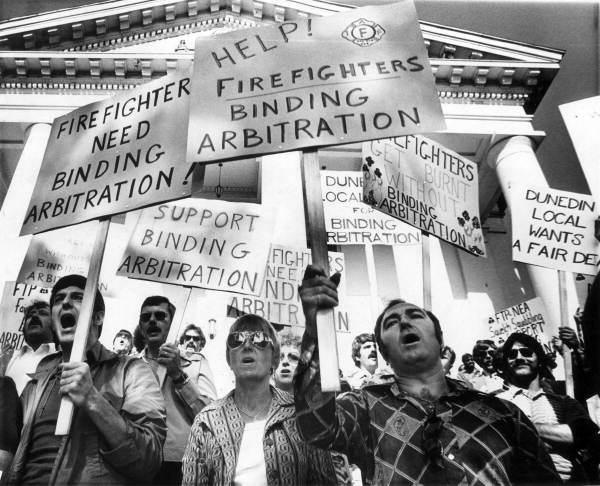Although Florida’s 1944 right-to-work law was amended in the 1968 constitution to ban public workers from striking, its collective bargaining language remained unchanged: “The right of employees, by and through a labor organization, shall not be denied or abridged.” This meant that employees should (in theory) be allowed to collectively bargain through their unions. Collective bargaining is a process where working people negotiate employment conditions with their employers through their unions (versus as individuals with little leverage).
In practice, however, most public employers were not engaging in collective bargaining laws. This led to successful pushes for collective bargaining rights for teachers in 1968 and limited local rights for firefighters with the Firefighters’ Collective Bargaining Act of 1972. Still, these efforts only applied to a subsect of public workers. By the 1970s, the share of Black Floridians in the public sector had risen to 18 percent (nearly one in five government workers), so they were increasingly impacted by laws regulating union activity.
In 1969, the state redrew its districts again, resulting in new elected officials and setting the stage for broader worker-friendly legislation. Even still, the Legislature delayed passing a law to protect workers’ collective bargaining rights until the Florida Supreme Court warned in 1972 that it would create guidelines itself if no legislation was implemented. Consequently, Florida passed the Public Employees Relations Act (PERA) in 1974.[1] PERA made clear that all Florida’s public workers were entitled to collective bargaining and could join and form unions, and a commission was created to implement such policies for the public sector. PERA was a significant step forward and Florida was the first Southern state to pass a workplace law that covered all public workers but it still explicitly banned Floridians from striking. Nevertheless, movement gains helped drive more Black Americans into the middle class than ever before.
To this day, public workers are not allowed to strike. Disturbingly, in 2023, the state passed a new law (SB 256) that threatens to undo all of PERA’s gains. The law prevents most public unions[2] from deducting dues from members’ paychecks, requires 60 percent membership for a union to engage in collective bargaining, and requires local unions — most with small budgets of less than $5,000 annually — to pay for private audits of their financial records. These barriers threaten union membership and their survival.
This is significant because as of 2022, 58 percent of Florida’s union members were public workers. Public employees work either for the state or local governments (counties, cities). Today, 27 percent of Florida’s public workers are people of color. Looking at state employees in particular, nearly half (45 percent) are people of color. This data shows that Florida unions overwhelmingly benefit public workers, including a significant share of Black and Brown people. As such, repealing PERA’s gains is a drastic affront to working Floridians’ power, especially the growing share of public workers of color.
References:
[1] PERA is now Chapter 446, Part II of the Florida Statutes.
[2] In 2018, the Florida Legislature passed HB 7055 to target teachers and their unions, requiring units to have 50 percent membership to engage in collective bargaining with employers. Teachers surpassed this threshold, then it was increased to 60 percent in SB 256. Originally designed as a way to target teachers unions in particular, SB 256 was expanded to apply to all public sector unions except those representing firefighters and police, probation, and correctional officers.
